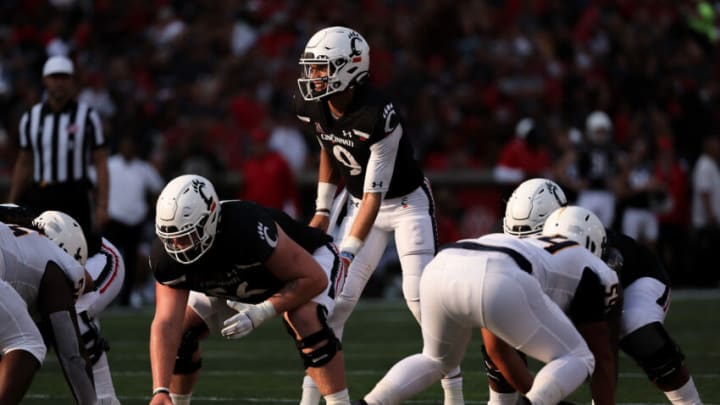The Notre Dame football team takes on a tough opponent in Week 5, and here is how they can stop the Cincinnati Bearcats explosive offense.
Coached by longtime Brian Kelly assistant and former Notre Dame football offensive coordinator, Mike Denbrock, the Cincinnati offense provides a unique challenge that gives a lot of their opponents in the AAC trouble, due to its break from the norm in the conference.
It’s an RPO-heavy approach that relies on a few key things. The first is a running back who can power between the tackles, the second is an athletic quarterback who makes smart decisions, the third is consistent if not great wide receivers who are willing to block, and the fourth is multiple tight ends who can handle the ball.
The average play will include an option to run up the middle or keep it with Ridder. Ridder often will roll to one side of the field, where he can find a receiver on the edge, a dragging or crossing tight end, or he can run it himself.
Make no mistake that Ridder is fast, even if he doesn’t always look it, the fourth-year starter takes long strides and he keeps plays alive. Denbrock, who has tight ends in his background, loves to make sure they’re included as much as possible in the offensive design.
Cincinnati will break up this type of RPO play with the occasional deep shot for one of their wide receivers. In the past, Desmond Ridder has struggled to hit these. Downfield passing always has been his weakness, but so far this season it’s clear that Ridder has cleaned up those throws.
He’s still not perfect on them, but he’s much better and overthrowing them much less than he used to. Other than those deep shots, Cincinnati likes to play underneath and physically. They don’t mind taking a long drive down the field
So, the question is, how does Notre Dame football stop this?
The first step is to get into the backfield and hit Ridder. One of Ridder’s strengths is his decision-making, but no one is going to make good decisions if they’re getting hit. That’s how turnovers are forced. It’s also how you knock Cincinnati off schedule.
Ridder is not a great pocket passer. Making him throw on third and long is a recipe to stop him. So, early tackles for loss, and a good crowd to force procedural penalties, can ruin Cincinnati’s day.
The second thing to do is to take away those big plays. Forcing them away from those big plays keeps the field shorter and lets your defense bunch up against the RPO, which needs space to operate properly. The third thing is also based around that RPO. Its design is that you make a decision, and your choice is wrong. Do you stop the run inside? We throw. Do you stop the slant? It’s a quarterback run.
And so it goes. So, if you’re Notre Dame on defense, stay assignment sound and make them choose to play into your strength on defense. Choose for them.

Notre Dame football vs. the Cincinnati Bearcats is a Playoff Game
Cincinnati and Notre Dame football meet in South Bend on Saturday in what can be seen as a midseason Playoff game, where the loser is out.
Finally, key in on those tight ends. They get used more than a lot of other modern college offenses. Figure out if it’s going to be a linebacker or a safety on them, and take away that safety valve. Otherwise, the Bearcats can try and papercut you to death.
